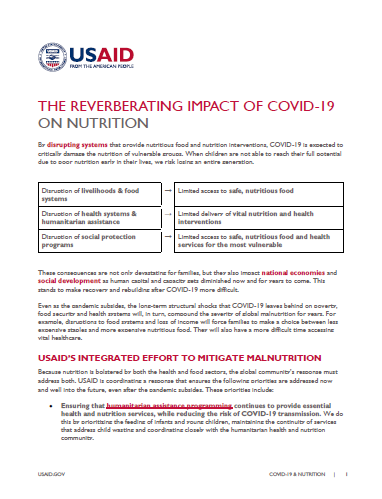Speeches Shim
By disrupting systems that provide nutritious food and nutrition interventions, COVID-19 is expected to critically damage the nutrition of vulnerable groups. When children are not able to reach their full potential due to poor nutrition early in their lives, we risk losing an entire generation.
- Disruption of livelihoods & food systems
- Limited access to safe, nutritious food
- Disruption of health systems & humanitarian assistance
- Limited delivery of vital nutrition and health interventions
- Disruption of social protection programs
- Limited access to safe, nutritious food and health services for the most vulnerable
These consequences are not only devastating for families, but they also impact national economies and social development as human capital and capacity gets diminished now and for years to come. This stands to make recovery and rebuilding after COVID-19 more difficult.
Even as the pandemic subsides, the long-term structural shocks that COVID-19 leaves behind on poverty, food security and health systems will, in turn, compound the severity of global malnutrition for years. For example, disruptions to food systems and loss of income will force families to make a choice between less expensive staples and more expensive nutritious food. They will also have a more difficult time accessing vital healthcare.
USAID’S INTEGRATED EFFORT TO MITIGATE MALNUTRITION
Because nutrition is bolstered by both the health and food sectors, the global community’s response must address both. USAID is coordinating a response that ensures the following priorities are addressed now and well into the future, even after the pandemic subsides. These priorities include:
- Ensuring that humanitarian assistance programming continues to provide essential health and nutrition services, while reducing the risk of COVID-19 transmission. We do this by prioritizing the feeding of infants and young children, maintaining the continuity of services that address child wasting and coordinating closely with the humanitarian health and nutrition community.
- Protecting safe access to nutritious food—particularly for infants, young children and mothers. We do this by supporting the commercial production of safe, nutritious food, including food fortification; encouraging local production of nutritious foods; and promoting safe market measures so consumers can continue to afford and access nutritious foods.
- Ensuring health systems continue life-saving nutrition services, while reducing the risk of COVID-19 transmission. We do this by prioritizing breastfeeding, complementary feeding (i.e., providing required nutrients outside of what breast milk can provide), providing vitamin A supplements, treating child wasting (i.e., rapid deterioration in nutritional status over a short period of time), and nutrition counseling and supplementation for expecting mothers.
- Protecting and strengthening social protection programming, with a focus on access to nutritious food and nutrition services. We do this by advocating for governments to ensure the continuity of existing social protection programming while expanding these services, as necessary.
- Ensuring that nutrition issues are a part of policy and programming discussions. We do this by participating and speaking up in key relevant fora, and ensuring that monitoring and analyses paint a full and accurate picture of COVID-19’s impact on nutrition.
MITIGATING THREATS TO NUTRITION IN UGANDA
USAID is adapting its existing programs to mitigate COVID-19’s threats to nutrition. In Uganda, USAID worked with local partners and the government to adapt our Integrated Community Agriculture and Nutrition Activity program to quickly assess the impact of COVID-19 on specific regions and determine what interventions were needed. When the country began its lockdown, the team sprang into action to:
- Integrate messages about proper handwashing and social distancing into ongoing nutrition messaging that is regularly shared via radio and community groups.
- Conduct surveys of what goods were available at local markets.
- Help women-owned businesses stay in operation by pivoting to meet pandemic-related needs, such as setting up washing stations in public places and making face masks.
- Teach mother care groups tips on how to get a sick child to eat—an effort that was originally targeted at malaria, but was quickly adapted to respond to COVID-19.
THE CRITICAL PATH AHEAD
As we battle the health crisis brought on by COVID-19, the entire global community must also work proactively to protect nutrition, especially among the most vulnerable, and ensure that nutrition is prioritized and integrated across all programs. Otherwise, we risk succumbing to a vicious cycle in which shocks to nutrition increase the risk of disease and death, which leaves communities less able to cope with the impact of COVID-19 and recover from it.


Comment
Make a general inquiry or suggest an improvement.